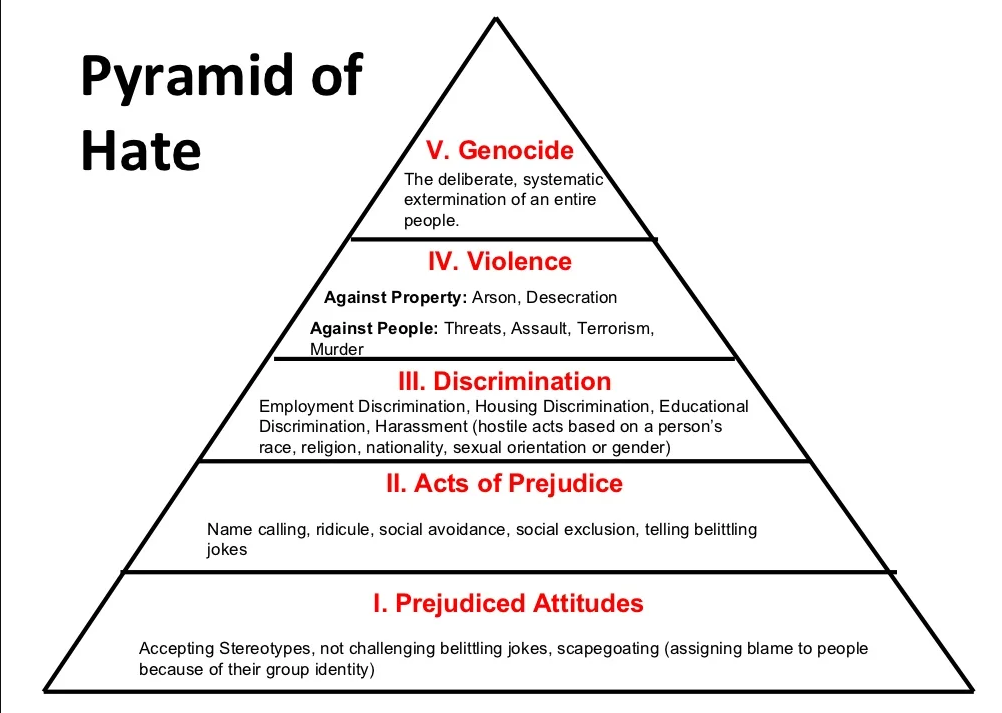What is the bystander effect?
The bystander effect occurs when the presence of others discourages a person from intervening in an emergency, against a bully, or during an assault or other crime. The more bystanders, the less likely it is for any one of them to initiate help.
Why is it important for bystanders to act?
Crimes and harmful behaviours such as sexual harassment and hate crime are under-reported by the victims. There are a number of reasons for this, but a key factor is the everyday nature of these incidents, but they are often likely to escalate if not addressed.
The pyramid of hate
This shows how hate can become ‘normalised’ and escalate if not challenged or addressed. Behaviours motivated by bias can snowball from words and exclusion, to discrimination, crime, violence and, in the most extreme cases, to systematic extermination.
Disrupting or stopping that escalation early on makes it more difficult for that behaviour to flourish, and we can dismantle the whole pyramid.
In the end we will remember not the words of our enemies but the silence of our friends.
Martin Luther King Jr

What stops you being an active bystander?
There are several reasons why people don't act to help when witnessing crimes or incidents involving violence, intimidation, harassment or hostility:
- We fail to notice the crime or incident – or see things on such a regular basis that we become immune to these incidents
- We fail to recognise the seriousness of the event
- We fail to take any personal responsibility - assuming that someone else is helping so we don't need to do anything
- We lack the knowledge or competence to offer appropriate help, and worry about being judged
- We are concerned that if we intervene, we could put people in danger
- We fear legal consequences
- We lack empathy - it's not happening to us or someone we care about. This may also be due to unconscious bias - which can make people less likely to help.
- We question whether we have the authority to get involved
What do we mean by ‘active bystander’?An active bystander (or upstander) means being aware of when someone's behaviour is inappropriate or threatening and choosing to intervene and offer assistance. |
How can we be active bystanders?
- Don't expect others to be the first to act
If you are with others when you witness a crime, your first instinct, and that of the others around you, might be to not intervene. Once someone helps, then others will join in because a new social norm emerges. Be that person who takes the first step to ensure the victim's safety.
- Take responsibility to do something
If you're in a position to help, tell yourself this is now your responsibility. Don’t be influenced by other people who aren’t doing anything. Try not to worry about the consequences of helping. Remember a lot of cruelty and violence is intra-familial, so don't be put off intervening just because you think the people involved are from the same family. Instead, think about the positive impact you can have and the example you set for those around you.
- Encourage others to get involved
Be an influencer. If you need assistance, ask particular people near you to do specific things. Look them straight in the eyes or single out someone by a distinguishing feature – e.g. blue jumper, glasses, pink face mask - and ask for their help. By directly asking someone, there is a good chance they will feel a shared responsibility and take some action.
- Empathise with the victim
People are more likely to help if they identify with a victim. Try imagining the victim is someone you love and ask yourself what you would like others to do to support them in those circumstances.
- A small act of kindness can make a big difference
Asking "Are you okay?" when it’s safe to do so, lets the victim know that you acknowledge what happened to them was unacceptable. This can be reassuring for the victim.
- Call for support
If it is not safe to intervene, call the police.
The more we show concern for others and become active rather than passive bystanders when we think someone may be at risk, the more likely it is we can help prevent tragedies like the appalling murder of James Bulger. This was a crime that "opened the gates of hell" for the witnesses who saw James being led away, wishing they'd done something to help him for the rest of their lives.
Find out about free bystander training.
